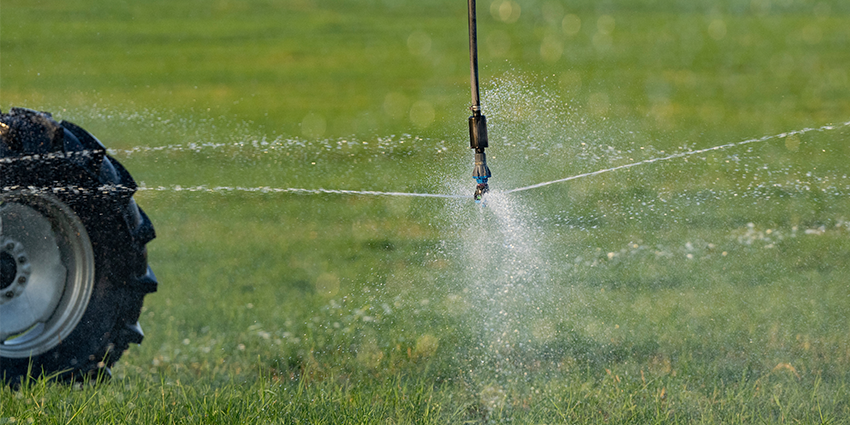Center-pivot irrigation in Texas. (Photo by Sam Craft, Texas A&M AgriLife Marketing and Communications.)
Peer-reviewed publications by Texas Water Resources Institute and Texas A&M AgriLife scientists
Free weather forecast and open-source crop modeling for scientific irrigation scheduling: proof of concept: Co-authored by TWRI Interim Director Allen Berthold, Ph.D., former TWRI Graduate Research Assistant Shubham Jain, and former TWRI Senior Irrigation Specialist Ali Ajaz, Ph.D., this paper studies how weather forecasts can be used to enhance scientific irrigation scheduling tools. Using predicted forecasts alongside irrigation schedules, the researchers observed corresponding crop yields for comparative analysis. This approach could support water conservation efforts in weather-data-poor and low-adoption regions.
Impacts of vegetation and topsoil removal on soil erosion, soil moisture, and infiltration: Over a 1-month period, this study looked to determine the impacts of soil mechanical disturbance and topsoil removal on soil erosion and deposition, soil moisture, soil water infiltration and vegetation type in a central Texas subtropical grassland setting. Co-authored by TWRI Research Specialist Stephanie Devilleneuve, the research found that removal of top soil caused erosion, and high levels of erosion could pose water quality threats to surface water bodies.
A harmonized characterization of drainage units on the African continent: In a linguistically diverse region like Africa with over 2000 different spoken languages, it is typical to find a waterbody, along its course, described by a plethora of different names. Co-authored by TWRI Research Specialist Duncan Kikoyo, Ph.D., this article describes and implements a hierarchical framework that harmonizes the description, classification, and coding of drainage units on the African continent. This paper’s characterization provides a high-resolution basin boundary dataset that improves data compatibility and accuracy and is expected to support catchment-based research and application on the continent.
Comparison of on-site versus NOAA’s extreme precipitation intensity-duration-frequency estimates for six forest headwater catchments across the continental United States: Flooding induced by extreme rain events has a major impact on infrastructure across the U.S., increasing the need for accurate precipitation intensity-duration-frequency (IDF) estimations. The U.S. Department of Agriculture Forest Service (USDAFS) manages approximately 370,150 miles of roads and thousands of road-stream crossing structures. Kikoyo and co-authors from USDAFS, the U.S. Environmental Protection Agency, and the University of North Georgia developed precipitation intensity- duration-frequency (PIDF) estimates from onsite long-term high temporal and spatial resolution precipitation data at six USDA Experimental Forests across the U.S. and evaluated the resulting onsite-IDFs against the IDFs from NOAA-Atlas14 and NOAA-RFA by comparing their relative differences and storm frequencies.
Comparative evaluation of the performance of SWAT, SWAT+, and APEX models in simulating edge of field hydrological processes: This study, also co-authored by Kikoyo, compares three different types of hydrologic and water quality models to assess which is the most suitable and gives results closest to reality. The three models were used to simulate the edge of field processes for a plot in Riesel, Texas, and to predict water yield, soil, and mineral phosphorous loss from the micro watershed.
Water-related research and news from universities around Texas
Water quality performance assessment of two stormwater detention basins located in the recharge zone of a karst aquifer: Scientists at the University of Texas at San Antonio studied the Edwards Aquifer in San Antonio over a year to quantify the water quality and hydrologic performance of the stormwater detention basins of cities drawing water from the karst aquifer. Results from the study have important implications for the operation and maintenance of stormwater basins constructed over recharge zones of the aquifer.
Influences of wastewater treatment on the occurrence of Parabens, p-Hydroxybenzoic Acid and their Chlorinated and Hydroxylated transformation products in the Brazos River (Texas, USA): This study evaluates both parabens and paraben transformation products in the Brazos River upstream and downstream of a wastewater facility located in Waco, Texas. Baylor scientists collected at least 40 samples from the river, along with two Brazos River tributaries, to determine if they released parabens and related compounds into the Brazos. Found compounds were collected and analyzed.
Impacts of groundwater pumping for hydraulic fracturing on aquifers overlying the Eagle Ford Shale: Texas A&M University scientists found that groundwater pumping for hydraulic fracturing caused about 65 feet of drawdown in nearby wells and captured recharge from an overlying aquifer.


